4 Best Lat Exercises with Bands (with Pictures!)
When doing a lats workout routine, people often think of the lat pulldown machine, dumbbell pullovers, or barbell rows.
However, resistance bands are far too often associated with physical therapy and as a device of convenience and portability, and thus limited to home use or when trying to squeeze in a workout during idle hours in the office. However, resistance bands offer several benefits and advantages that no other gym device can offer or match.
The variable tension of the resistance bands recruits the smaller stabilizer muscles to a greater degree and promotes greater muscular activation at the top of the exercise’s range of motion; It also allows anyone to perform exercises at any position.
Benefits of Exercises with Resistance Bands
Though it was never determined who first invented resistance bands, nevertheless, a man named Gustav Gossweiler patented his design for an "Apparatus for Gymnastic Exercises for Manifold Use" in Switzerland on May 28, 1895, and in the United States on June 23, 1896.
This "gymnastic apparatus" was described in the patent to provide the same benefits we get from today's resistance bands.

Even the device's portability was mentioned in the patent and offered as a low-cost alternative to gym equipment.
Since then, the unusual device has become well-liked among fitness professionals as a cutting-edge exercise tool due to the benefits it offers.
1. It Suits Any Fitness Level
Resistance bands provide a full-body workout regardless of a person's fitness level.
Most resistance band product variations are available in the market and offer adjustable tension. The different tensions offered by resistance bands vary from 5-200 lbs. Even those recovering from an injury can utilize a resistance band for rehabilitation exercises.
There are two classifications for resistance bands:
- Loop bands
- Tube bands
Loop bands are made of a single, looped piece of flat rubber. There are also long and short variations of the loop bands. While tube bands are made of stretchable tubes and have handles on each end.
2. Affordable, Portable, and Versatility of Use
No gym equipment can beat resistance bands when it comes to affordability, portability, and versatility. However, some might ask why even bother buying any equipment when one can do bodyweight exercises (calisthenics).
As with any training program, to progress, the parameters of a workout routine must be adjusted, such as the weight or amount of external force the muscles are working against.
Equipment used for calisthenics to add resistance costs a lot more than resistance bands.
Resistance bands can mimic just about any function of any equipment. Most of the time, it allows for easier and safer execution of most exercises. Due to their portability and lightweight features, people can bring these bands into their offices, on their travels, and on their morning run to throw in a few HIIT routines.
The only limiting factor of the resistance bands is the user's imagination.
3. Provides Similar Strength Gains Compared to Other Equipment
In a review by Lopes et al., they concluded that evidence from their study suggests that resistance training with elastic devices provides similar strength gains when compared to resistance training performed from conventional devices and machines.
4. Greater Muscle Activation
Cable machines are great as they offer constant tension throughout the motion, thereby exceeding the benefits of free weights in some exercises.
For example, when doing a biceps curl, a dumbbell feels lighter at the top of the motion resulting in a lesser degree of muscular contraction. While biceps curls performed with cable machines experience the same tension from the starting position to the top of the motion.
However, resistance bands offer greater muscular activation at the top of the movement as the tension keeps increasing as the bands are stretched further throughout the range of motion of any exercise.
The further the bands are stretched, the greater the tension, thereby producing greater muscle activation at the movement's top.
5. Resistance Bands Allow Training of the Lats at Any Position
One can perform lats exercises standing, sitting, or even lying with resistance bands. All they need is a strong anchor like a post, a tree, a beam, a durable hook, or a door anchor.
Additionally, even the feet, legs, neck, and back can all be used as an anchor for the bands.
Muscles Worked by Lats Exercises
Along with the levator scapulae, trapezius, and rhomboid muscles, the latissimus dorsi, or the lats, is a member of the superficial extrinsic back muscles.
Both brachial and thoracic movements are attributed to the latissimus dorsi muscle, such as the pulling motion in lats exercises.
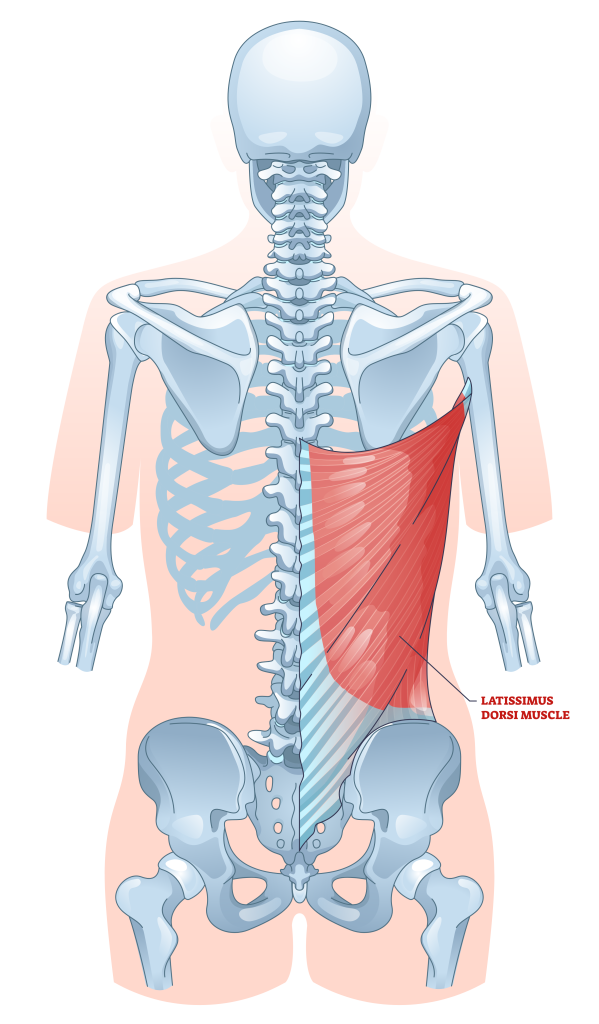
The lats - the widest muscle in the body - encompass almost all of the back muscles at the posterior trunk, except the trapezius. It is connected to the humerus, scapula, pelvis, ribs, and spine. It works on the shoulder joint to extend, rotate, and adduct the arm.
The rhomboids, teres major, teres minor, and infraspinatus are only a few of the lesser muscles in the upper back and shoulder that the scapula is attached to.
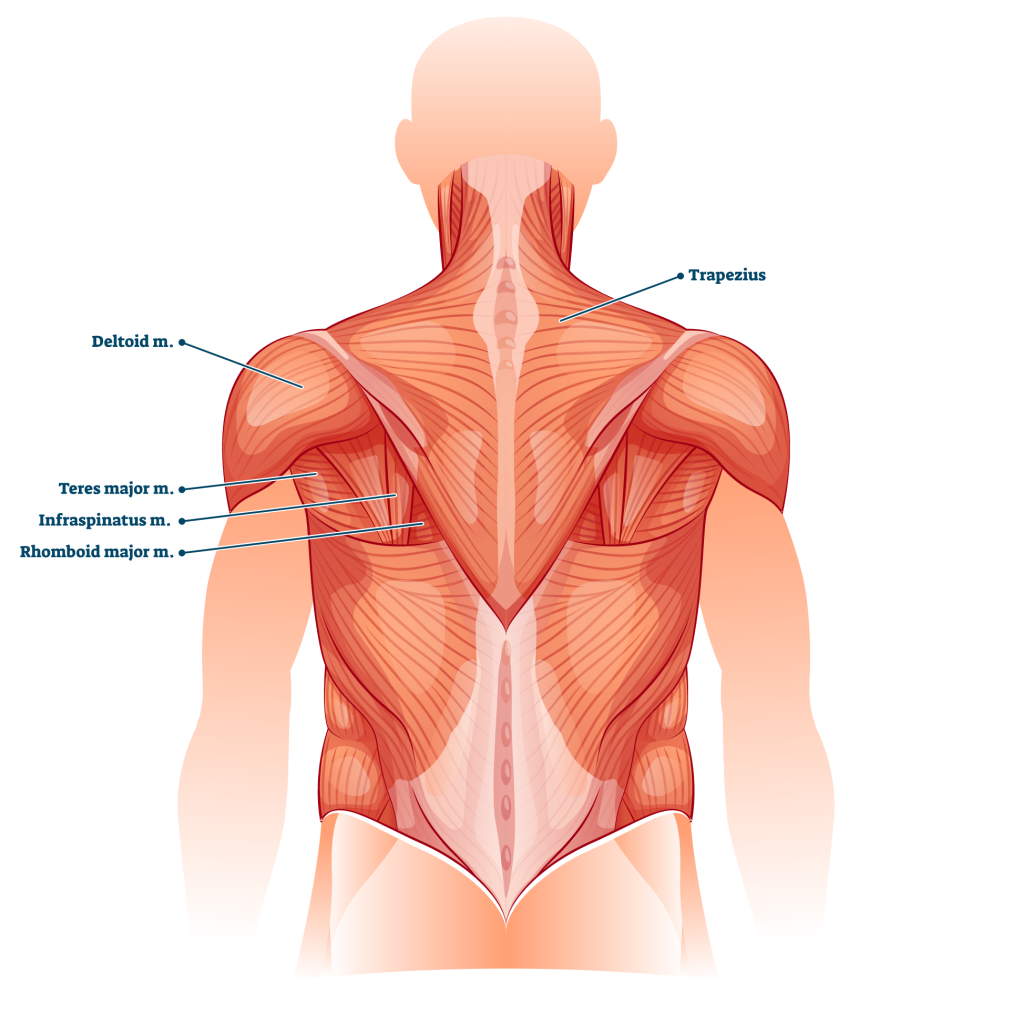
The upper back muscles and the lats work together to allow the arms to move around the shoulder joint. They also aid in regulating and stabilizing scapular movement when conducting lats exercises.
The trapezius, sometimes known as the traps, is a large, diamond-shaped muscle that connects the neck, shoulders, and upper back.
The lower traps are significantly used in exercises that involve pulling motions.
Best Lats Exercises with Bands
When deciding to acquire a set of resistance bands, it is advised to include a door anchor, as this device will allow you to hook the resistance bands and do exercises anywhere there is a door to fasten that anchor.
1. Lat Pulldown
A lat pulldown workout usually needs expensive cable machines to perform. However, with resistance bands, all one needs is a beam or a door anchor securely placed above the door, and they're good to go.
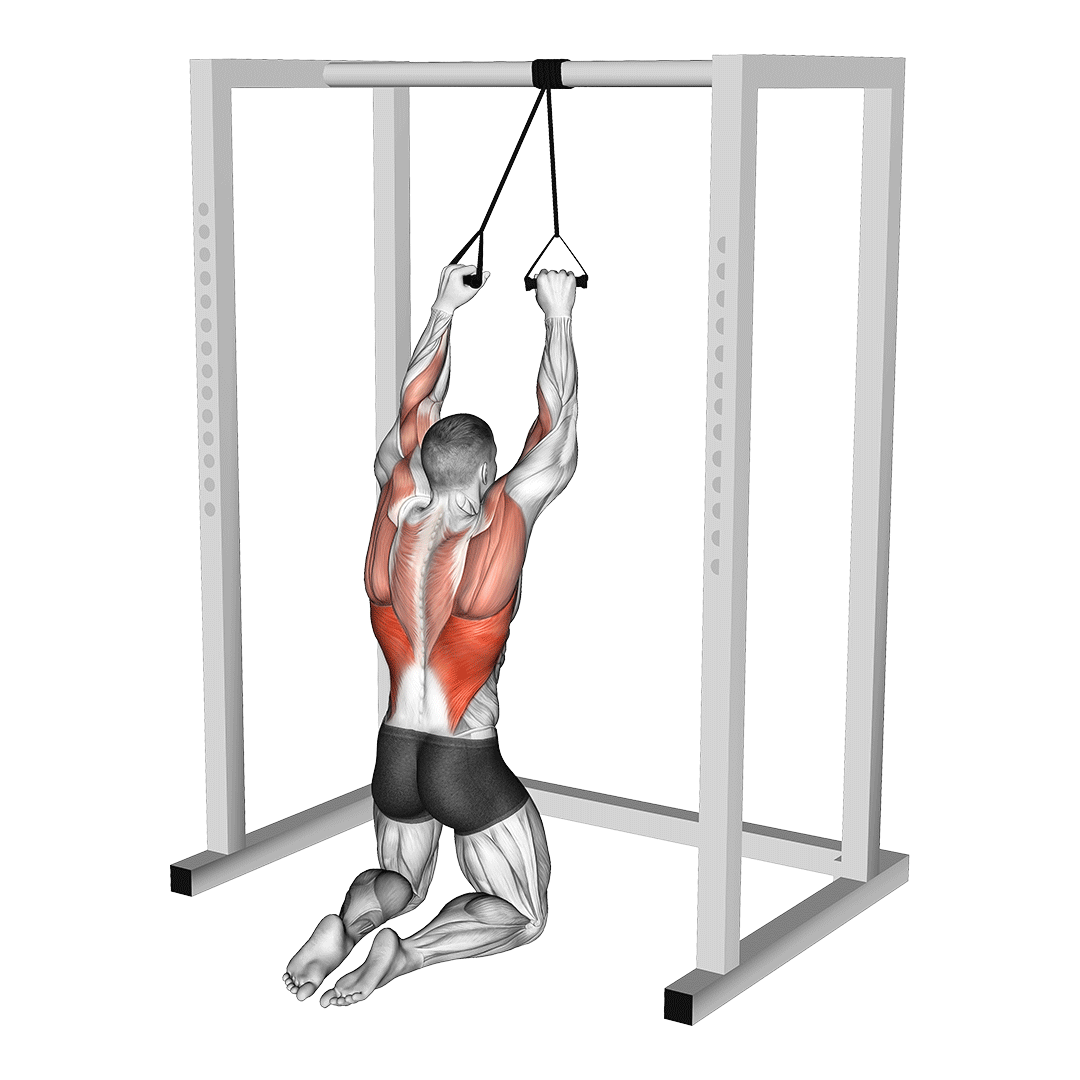
Using a door anchor or securing the band around a stair's baluster, grab both ends of the band with each hand. This exercise can be performed standing, seated on a chair, or kneeling with the arms extended and the body tilted forward from the hips at the angle of the band from the door.
Pull down on the bands until the elbows are at the sides of the body, then slowly extend the arm back to the starting position. Repeat the movement for the desired number of repetitions.
2. Bent-Over Row
This exercise can be executed anywhere there is solid ground to stand on and does not even need any fixed object for an anchor but the feet.
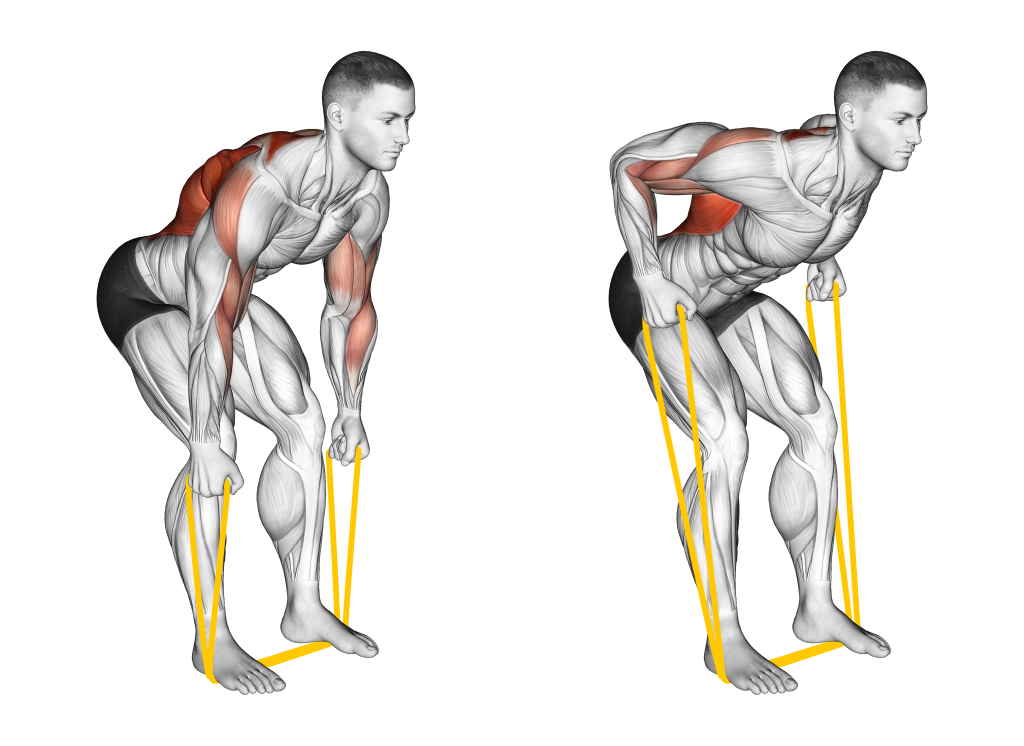
Start by stepping on the middle of the resistance bands with both feet. Grab the handles and bend the body at the hips. With knees slightly bent, keep the back straight at all times.
Pull the bands until the elbows are behind the body. Reverse the action back to the starting position. Repeat.
3. Back Rows
Back rows, being a pull exercise, are excellent in targeting the shoulder muscles and the muscles situated at the rear side of the trunk including the lats, rhomboids, rear deltoids, and traps.
It also engages muscles used to flex the elbow such as the biceps, brachialis, and other forearm muscles. Additionally, this exercise may be done whether from a standing or a seated position.
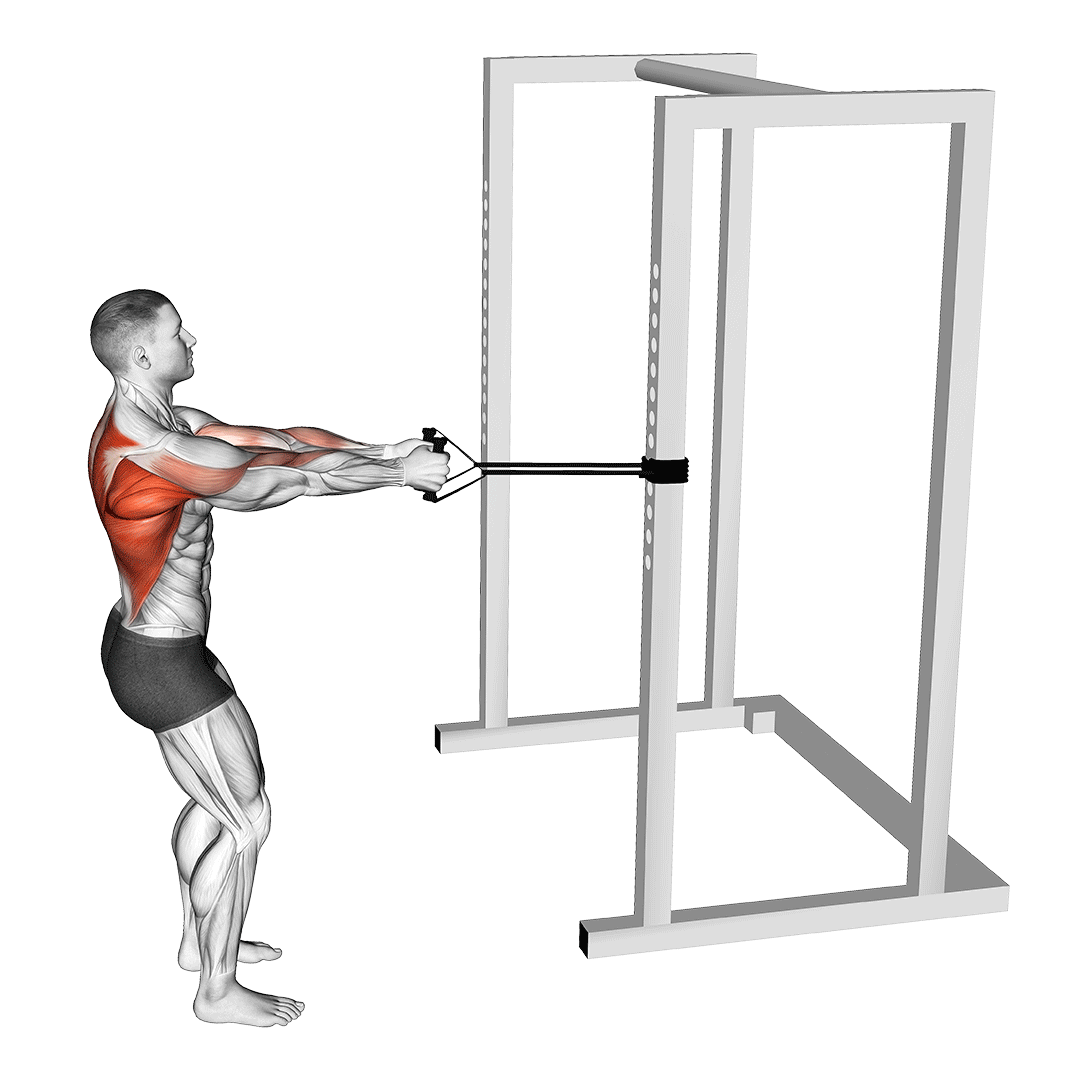
To do standing back rows, fasten a door anchor about chest height and pull the resistance bands back until desired tension is achieved.
Stand with feet shoulder-width apart and knees with a slight bend. Pull the band until the elbows are behind the body. Reverse the movement and repeat the action for several repetitions.
To perform this in a seated position, fasten a door anchor at ankle height or wrap the bands on the leg of a heavy table. Sit on the floor with knees slightly bent. Grab the handles with band's handles with a neutral grip. Keep the body erect and perpendicular to the floor.
Slowly pull the handles while keeping elbows close to the sides of the body. As the hands touch the body, squeeze the shoulders, reverse the action back to the starting position, and repeat the movement for several repetitions.
4. Seated Lat Pullover
One of the finest methods to specifically develop the lats is by doing lat pullovers.
The lats are commonly trained by performing compound exercises such as pull-ups and rows, but pullovers not only primarily target the lats, but also provide variation to the lat training routine to challenge the muscles and influence better muscle gains.
To perform seated lat pullovers, secure an anchor at the top of the door. Attach the bands on the anchor and sit on the floor with the back press against the door. Grab the handles with a slightly pronated grip and begin with arms over the head with a slight bend on the elbow.
Pull the bands with arms straight until the hands are a bit lower than the height of the chest. Then, slowly reverse the motion until the hands are back at the starting position.
Repeat movement for the desired number of repetitions.
Final Thoughts
Fortunately, the availability of inexpensive stretchable tubes or flat bands, usually made from a synthetic rubber called latex, enables anyone to exercise anytime and anywhere.
People who missed a day in the gym, those undergoing rehabilitation from an illness or injury, and even fitness buffs wanting to take their lats training to another level due to the bands’ propensity to promote greater muscle activation as its tension increases at the top of the range of motion, benefit greatly from resistance bands.
The versatility and wide application of resistance bands when it comes to fitness have no limits.
References
1. Lopes JSS, Machado AF, Micheletti JK, de Almeida AC, Cavina AP, Pastre CM. Effects of training with elastic resistance versus conventional resistance on muscular strength: A systematic review and meta-analysis [published correction appears in SAGE Open Med. 2020 Sep 9;8:2050312120961220]. SAGE Open Med. 2019;7:2050312119831116. Published 2019 Feb 19. doi:10.1177/2050312119831116
2. Bergquist R, Iversen V, Mork P, Fimland M. Muscle Activity in Upper-Body Single-Joint Resistance Exercises with Elastic Resistance Bands vs. Free Weights. Journal of Human Kinetics. 2018;61(1): 5-13. https://doi.org/10.1515/hukin-2017-0137
3. Jeno SH, Varacallo M. Anatomy, Back, Latissimus Dorsi. [Updated 2022 Apr 5]. In: StatPearls [Internet]. Treasure Island (FL): StatPearls Publishing; 2022 Jan-. Available from: https://www.ncbi.nlm.nih.gov/books/NBK448120/
4. Jennifer K H, Daniel A J, Todd C. A Comparison of Muscle Activation during the Pull-up and Three Alternative Pulling Exercises. J Phy Fit Treatment & Sports. 2018; 5(4): 555669. DOI: 10.19080/JPFMTS.2018.05.555669.
